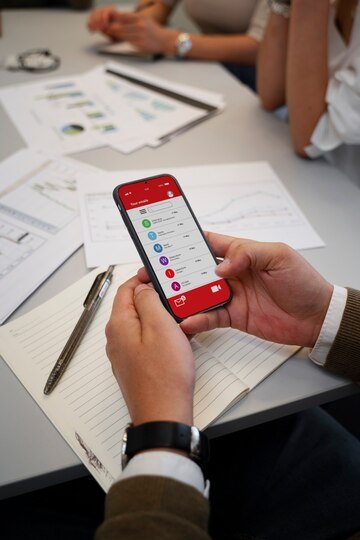Frequently, we encounter customers who have fantastic ideas for new applications and are eager to see their creations produced and released into the market. However, the fact is that developing an app still requires resources and time, even when utilizing Agile or lean software development approaches.
While many aspects are taken into consideration while developing a mobile app, the first version of an app must be completed within three months, and applications requiring additional features and sophisticated functionality must be completed within six months. The mobile app development lifecycle has many crucial stages that are essential to overlook.
Mobile App Development Company New York is an exemplar of leadership in the thriving tech scene of New York City. It provides businesses and entrepreneurs seeking to launch their app ideas in one of the most competitive markets on the planet with specialized solutions and knowledgeable advice. The company combines creativity, technical know-how, and market intelligence to create effective digital solutions.
Let’s look more closely at the stages of mobile app development from beginning to end to get a better picture of how long it takes to construct a mobile application.
1. The Phase of Discovery
Every app starts with an idea. This concept is often developed into a solid foundation for a mobile application.
Refining the app’s concept is the goal of the discovery or conception phase of the mobile app development lifecycle. There are several basic questions you must ask yourself in order to design a successful product. Before releasing your app on any app store, you should take the following into account. The issues of how long it takes to construct an app and how much money is needed may be answered reasonably accurately if this app development stage is effective.
Competitive Advantage: Are there currently comparable applications on the market? If the response is in the affirmative, how does your app stand out from those?
Infrastructure Integration: What current infrastructures will the application enhance or integrate? Additionally, applications must be considered in light of the mobile form factor:
How will the application function in a mobile form factor? How can I use technology like cameras and location awareness to create value?
Value: What benefit will this app provide to its users? What purpose will they put it to?
Determining Use Cases and Actors may be helpful for an app’s functionality and design. Actors, who are often users, refer to roles inside an app. Conversely, use cases are intentions or activities.
An application for task tracking, for instance, may include two actors: a user and a friend. One might make a task and share it with a friend. Together with the actors, the two clearly separate use cases for generating and distributing tasks in this scenario will direct you on the screens you must create as well as the kinds of business entities and logic you must create.
Within the rapidly evolving technological landscape of Los Angeles, Mobile App Development Los Angeles acts as a catalyst for digital growth, collaborating with both startups and enterprises to develop fully involved mobile experiences that deeply connect with a wide range of audiences. By adjusting on the city’s inventive spirit and technological prowess, “Mobile App Development Los Angeles” ensures that modern ideas are tangible and easily accessible to users.
It is much simpler to begin the app design process after a sufficient number of actors and use cases have been identified.
2. The Stage of Design
You already have an idea of the kind of app you want to create at this point in the app development process. All the necessary nuts and bolts have been installed. The moment has come to begin system development.
As they are fully aware of the project specifications, begin by putting together your ideal team. Make a project workflow design and chart to establish the limits of individual tasks. At this point, the team’s role, primary duties, and functions are clarified and recorded.
As development moves further, this will save a substantial amount of time and project expenditures. Additionally, staff members get training on any additional project needs throughout the development phase.
As a general guideline, mobile developers should create a lightweight prototype first to see whether it is workable and practical. The prototype is crucial for determining if the project has access to the necessary technology to meet the goals of the app right away.
It’s time to proceed to the following phase when the duties allocated to pertinent departments have been approved.
3. The Phase of Development and Testing
Now that the design phase has been effectively concluded, the software development team may go to work on the project. The process of development is iterative and cyclical. It works in tandem with testing to ensure that any problems or mistakes in the software are found and fixed as soon as possible.
Now is also the time to conduct routine evaluations to monitor the project’s development and make sure everything is moving along as planned.
The product must undergo further testing when it is finished to make sure that every part of the application functions as a whole.
During the quality assurance stage of the development of mobile apps, the product is checked to make sure it complies with all specifications. Under no circumstances may you omit this step or take shortcuts with it, since your project could not succeed.
React Native for mobile app development helps the construction of cross-platform applications by means of a solitary codebase, thereby promoting creation and keeping ease across the iOS and Android platforms.
4. The Development Stage of Deployment Apps
After going through extensive development and testing, the software is now prepared for public release. Now is the time to enlist the aid of the marketing and promotion team to aid in the app’s widespread adoption. The app’s formal release date ought to symbolize the pinnacle of the marketing campaigns for it so far.
Influential journalists and bloggers should produce articles and write-ups on the app to generate buzz for the marketing team. The group must also notify everyone who expressed interest in the app prior to its release. Email blasts and social media mentions are two more ways to publicize the release. The goal is to generate some momentum and get downloads and ratings.
The software itself is not nearly as vital as a strong marketing campaign. As a result, be careful to never undervalue the marketing portion of the procedure.
5. Updating and Maintenance Stage
The release of your product does not mark the end of the application development lifecycle. It’s critical that you continue to provide required updates and maintenance for your product after consumers have it.
This is significant because it prevents a scenario in which the rate of app retention declines. The post-development phase is another term for the time of updates and maintenance.
In summary
The creation of apps doesn’t stop with release. There will be a flood of customer feedback when your app is downloaded, which you must take into account for further releases.
At Linkitsoft, It might seem difficult, particularly to people who are creating apps for the first time. Nevertheless, the evolution will become more predictable as one becomes used to it.
With any luck, this post will help you understand the many phases involved in developing a mobile app, as well as what occurs at each one and why it matters.


